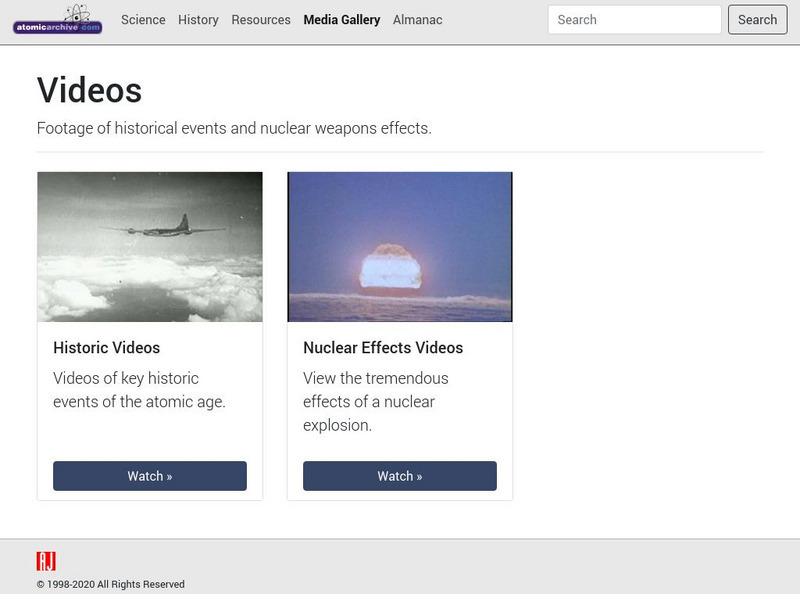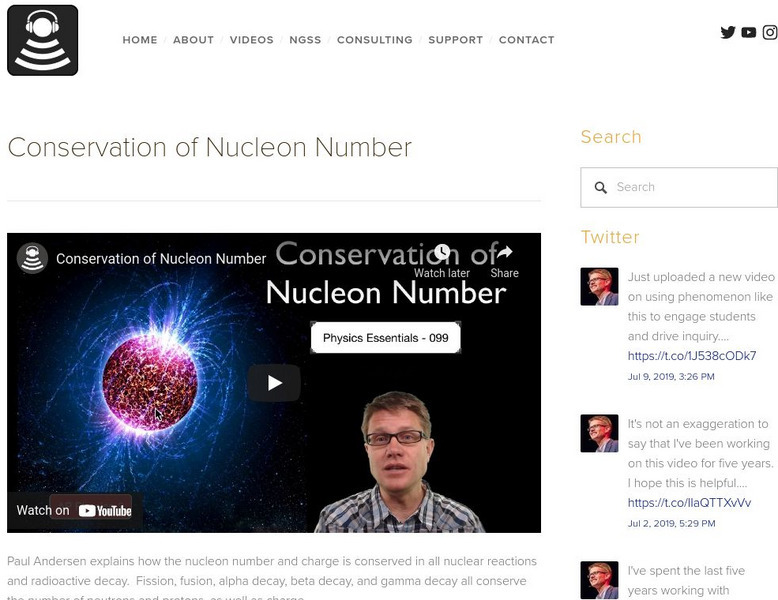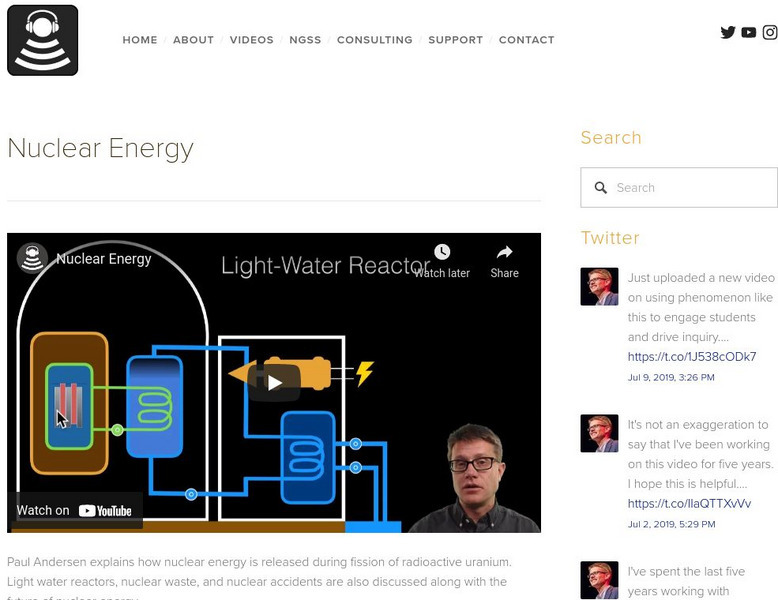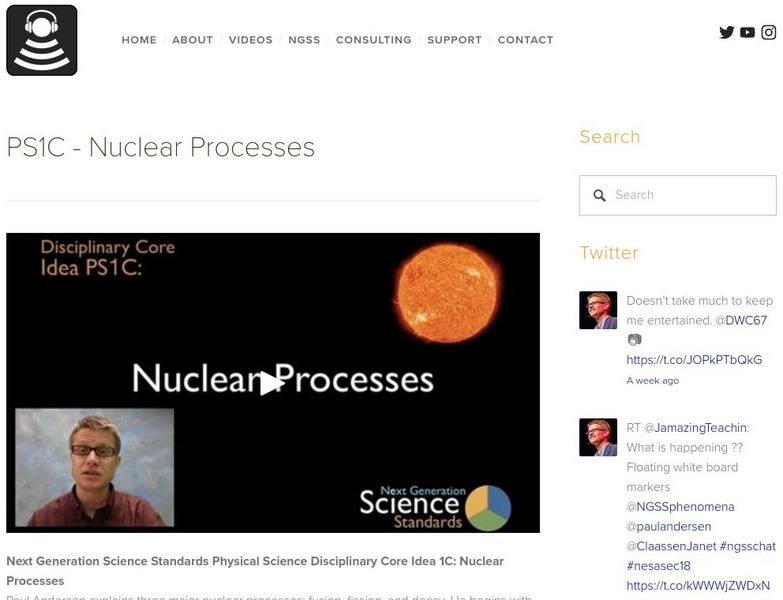Crash Course
Nuclear Chemistry Part 2: Fusion and Fission
Go into depth with an investigation of fusion and fission area, how they work, the pros and cons and the many dangers of these reactions. The video also covers e = mc^2 and mass defects.
Crash Course
Nuclear Chemistry
Radioactivity and nuclear chemistry, transmutation of elements and isotopes, calculating half lives and radioactive decay. Introduce these concept and more with a video on carbon dating. The show concludes with an explanation of...
Bozeman Science
Cell Division
It is hard to believe a 300-foot-tall Redwood tree began as a single cell hundreds of years ago. How did it grow so large? Observe how different kinds of cells (bacteria, sex cells, and eukaryotic cells) reproduce or make more cells...
Curated OER
Fission And Fusion
Here is a high-quality presentation of how forces hold atoms together, but can be unstable in larger atoms. Fission and fusion are explained with colorful animated graphics and energy graphs. Explanations are elaborate, making this...
California Academy of Science
Nuclear Energy: Is Fission the Future?
Nuclear energy powers the Mars rovers as well as provides energy in more than 30 countries around the world. While some believe nuclear energy is the future of energy production, others worry about the risk factors and radioactive waste....
Nature League
What is Reproduction? - Lesson Plan
What force drives a species' will to survive and thrive? Explore reproduction through the first of a four-part video series. The narrator discusses both sexual and asexual reproduction and cites examples of each.
Bozeman Science
PS1C—Nuclear Processes
Need some strategies for teaching nuclear processes that are sure to cause an explosion of learning in your classroom? Get all the essential background knowledge, plus tips for getting your point across in a thoughtful...
Teacher's Pet
Fission and Fusion
Harness that classroom energy to study fission and fusion. An interesting video lesson first explains the process of fission and fusion and then discusses practical uses. The instructor explains in detail the reactions in nuclear...
TED-Ed
What Are the Challenges of Nuclear Power?
Engineering challenges, construction costs, and disasters are some of the challenges when it comes to nuclear energy. Watch a video that explains each of these and more in detail.
SciShow
Sun vs. Atomic Bomb
The largest series of nuclear fusion reactions in our solar system has been happening for millions of years. The sun works in much the same way that atomic bombs work. Here is a video that describes how each work and the safety checks...
Bozeman Science
Nuclear Reactions
How does a nuclear reaction create such a large amount of energy? The idea of a nuclear reaction develops from a comparison with chemical reactions. The video instructor then explains the process of both nuclear fission and fusion. This...
DoodleScience
Nuclear Fission and Fusion
Lab closed, gone fission! This video discusses both fission and fusion and their relationship to each other. In addition, it also explains why uranium, plutonium, and hydrogen are used and which process uses which elements.
Atomic Archive
Atomic Archive: Animations
The Atomic Archive indexes a variety of downloadable and viewable videos which are present at the site. Some videos are have virtual reality feature, allowing the visitor to rotated and explore features an object (e.g., a bomb).
PBS
Pbs Learning Media: Nuclear Reaction: Fission
This video segment adapted from FRONTLINE looks at nuclear fission as an energy source that can be used to generate electricity. [2:49]
Bozeman Science
Bozeman Science: Conservation of Nucleon Number
In the following video Paul Andersen explains how the nucleon number and charge is conserved in all nuclear reactions and radioactive decay. Fission, fusion, alpha decay, beta decay, and gamma decay all conserve the number of neutrons...
Bozeman Science
Bozeman Science: Nuclear Energy
Paul Andersen explains how nuclear energy is released during fission of radioactive uranium. Light water reactors, nuclear waste, and nuclear accidents are also discussed along with the future of nuclear energy. [9:06]
Crash Course
Crash Course Chemistry #39: Nuclear Chemistry Part 2: Fusion and Fission
Hank discusses and explains nuclear chemistry with an in-depth look at fusion and fission.
Howard Hughes Medical Institute
Hhmi: Biointeractive: Planaria Regeneration Activity [Pdf]
Learn about regeneration by working with planaria, a freshwater flatworm. Discover how long it takes for the flatworm to regenerate a head.
Bozeman Science
Bozeman Science: Nuclear Reactions
Mr. Andersen contrasts nuclear reactions to chemical reactions. He explains the four main forces of nature; including gravity, electromagnetism, strong, and weak nuclear forces. He also explains how fusion differs from fission.
Bozeman Science
Bozeman Science: Nuclear Processes
Paul Andersen explains three major nuclear processes; fusion, fission, and decay. He begins with a brief discussion of the four fundamental forces in nature. He the explains how nuclei can be combined in fusion, divided through fission,...

















![Hhmi: Biointeractive: Planaria Regeneration Activity [Pdf] Instructional Video Hhmi: Biointeractive: Planaria Regeneration Activity [Pdf] Instructional Video](https://content.lessonplanet.com/knovation/original/260470-6a63271bb921656a42516f59c6666d53.jpg?1661251883)

